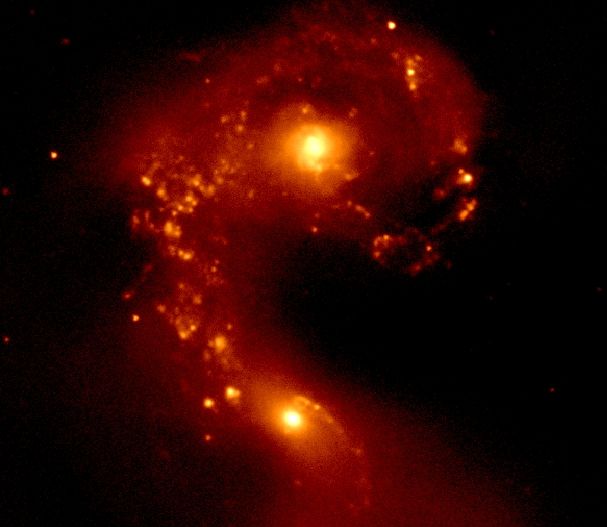Explanation: What happens when galaxies collide? One of the best studied examples of the jumble of star clusters, gas, and dust clouds produced by such a cosmic train wreck is the interacting galaxy pair NGC 4038 / NGC 4039, the Antennae Galaxies, only sixty million light-years away. In visible light images, long, luminous tendrils of material seem to reach out from the galactic wreckage, lending the entwined pair an insect-like appearance. But this penetrating view from the new Wide-field InfraRed Camera (WIRC) attached to the Palomar Observatory's 200 inch Hale telescope shows, in false-color, details of some otherwise hidden features. The large central nuclei of the two original galaxies dominate the near-infrared scene speckled with other bright sources which are themselves giant, newly formed star clusters. Remarkably the northern (topmost) nucleus, obscured in optical images, is also revealed here to have a barred, mini-spiral structure reminiscent of many "single" spiral galaxies.
1999 2000 2001 2002 2003 2004 2005 2006 2007 2008 2009 2010 2011 2012 2013 2014 2015 2016 2017 2018 2019 2020 2021 2022 2023 2024 2025 |
Yanvar' Fevral' Mart Aprel' Mai Iyun' Iyul' Avgust Sentyabr' Oktyabr' Noyabr' Dekabr' |
NASA Web Site Statements, Warnings, and Disclaimers
NASA Official: Jay Norris. Specific rights apply.
A service of: LHEA at NASA / GSFC
& Michigan Tech. U.
|
Publikacii s klyuchevymi slovami:
NGC 4038 - NGC 4039 - interacting galaxies - vzaimodeistvuyushie galaktiki - galaktika Antenna
Publikacii so slovami: NGC 4038 - NGC 4039 - interacting galaxies - vzaimodeistvuyushie galaktiki - galaktika Antenna | |
Sm. takzhe:
Vse publikacii na tu zhe temu >> | |
